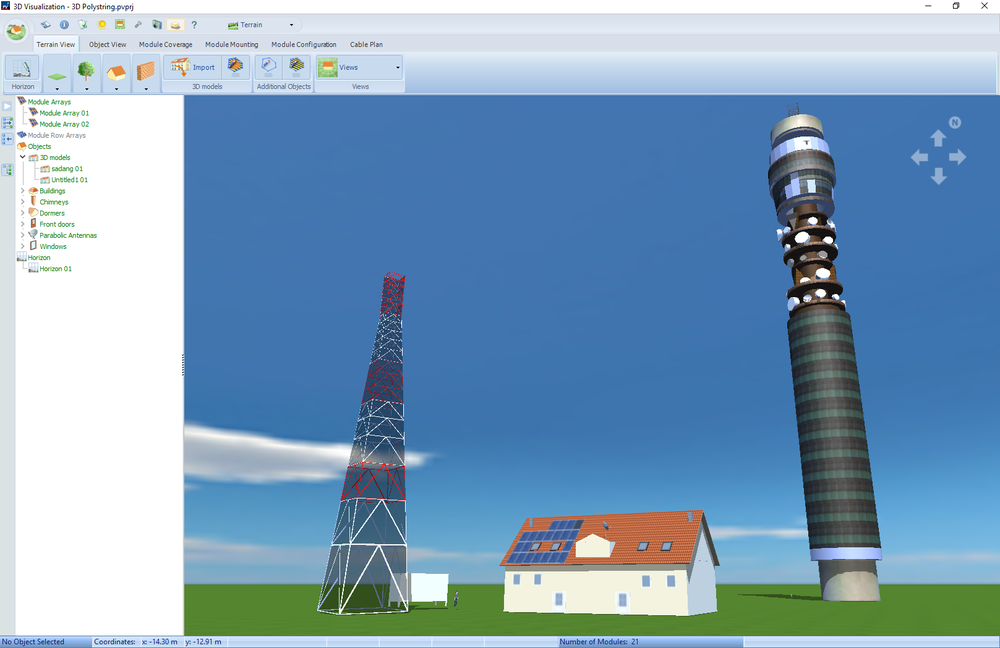-
Posts
1,845 -
Joined
-
Last visited
-
Days Won
172
Everything posted by developer_mh
-
Hallo, mittlerweile haben wir PV*SOL premium 2018 veröffentlicht, in der wir die Verschaltung von Power-Optimizern (Leistungsoptimierern) vollständig überarbeitet haben. Es können sowohl interne Power-Optimizer wie Maxim als auch externe wie SolarEdge und Tigo genutzt werden. https://www.valentin-software.com/aktuelles/produktneuheiten/neu-pvsol-premium-2018-import-von-3d-modellen Viel Spaß damit und beste Grüße, Martin
-
Hallo nochmal, nur fürs Protokoll: Die Simulation von PV-Systemen, Batterie-Speichern (DC oder AC-gekoppelt) und Elektro-Fahrzeugen ist in PV*SOL seit Version 2017 Release 6 möglich. Beste Grüße, Martin
-
Hallo, mittlerweile haben wir PV*SOL premium 2018 veröffentlicht, in der wir die Verschaltung von Power-Optimizern (Leistungsoptimierern) vollständig überarbeitet haben. Es können sowohl interne Power-Optimizer wie Maxim als auch externe wie SolarEdge und Tigo genutzt werden. https://www.valentin-software.com/aktuelles/produktneuheiten/neu-pvsol-premium-2018-import-von-3d-modellen Viel Spaß damit und beste Grüße, Martin
-
Hallo, mittlerweile haben wir PV*SOL premium 2018 veröffentlicht, in der wir die Verschaltung von Power-Optimizern (Leistungsoptimierern) vollständig überarbeitet haben. Es können sowohl interne Power-Optimizer wie Maxim als auch externe wie SolarEdge und Tigo genutzt werden. https://www.valentin-software.com/aktuelles/produktneuheiten/neu-pvsol-premium-2018-import-von-3d-modellen Außerdem können alle Arten von Polystring-Konfigurationen verschaltet werden: Unterschiedliche Modulflächen an einen MPP Tracker verschiedene Modultypen in einen String Parallelschaltung von Strings mit unterschiedlicher Modulanzahl usw usf Viel Spaß damit und beste Grüße, Martin
- 6 replies
-
- polystring
- Wechselrichter
-
(and 1 more)
Tagged with:
-
Hallo, in der neuen Version PV*SOL premium 2018 ist es möglich, eine ganze Reihe von 3D Modellen direkt zu importieren: https://www.valentin-software.com/aktuelles/produktneuheiten/neu-pvsol-premium-2018-import-von-3d-modellen Viel Spaß damit! Martin
-
Hallo! In der neuen Version von PV*SOL premium 2018 können alle Strom-Spannungs (I-V) und Leistung-Spannungs (P-V) Kennlinien angezeigt werden: Beste Grüße, Martin
-

Solaredge-Optimierer fehlen in Wechselrichter-DB
developer_mh replied to TechEditor's topic in PV*SOL
Hallo, mittlerweile haben wir PV*SOL premium 2018 veröffentlicht, in der wir die Verschaltung von Power-Optimizern (Leistungsoptimierern) vollständig überarbeitet haben. Es können sowohl interne Power-Optimizer wie Maxim als auch externe wie SolarEdge und Tigo genutzt werden. https://www.valentin-software.com/aktuelles/produktneuheiten/neu-pvsol-premium-2018-import-von-3d-modellen Viel Spaß damit und beste Grüße, Martin -
Hi, just a short update: In the meanwhile we fully overhauled the design and simulation of PV plants with power optimizers, both module integrated (like Maxim) and external (like SolarEdge or Tigo). It is available in PV*SOL premium 2018. https://www.valentin-software.com/en/news/product-news/new-pvsol-premium-2018-import-3d-models Martin
-
Hi, just a short update: In the meanwhile it is possible to import a number of 3D model formats directly in PV*SOL premium (from version 2018 on): https://www.valentin-software.com/en/news/product-news/new-pvsol-premium-2018-import-3d-models Martin
-
Hi, just a short update: In the meanwhile we fully overhauled the design and simulation of PV plants with power optimizers, both module integrated (like Maxim) and external (like SolarEdge or Tigo). It is available in PV*SOL premium 2018. https://www.valentin-software.com/en/news/product-news/new-pvsol-premium-2018-import-3d-models Martin
-
Hi, just a short update: In the meanwhile we fully overhauled the design and simulation of PV plants with varying module areas. You can now build any configuration you want with the new 'Polystring feature'. For example: Two module areas on one MPP tracker Different module types in one string Parallel connection of strings with different number of modules etc etc It is available in PV*SOL premium 2018. https://www.valentin-software.com/en/news/product-news/new-pvsol-premium-2018-import-3d-models Martin
-
Hi, just a short update: In the meanwhile it is possible to import a number of 3D model formats directly in PV*SOL premium (from version 2018 on): https://www.valentin-software.com/en/news/product-news/new-pvsol-premium-2018-import-3d-models So, you can also search for BTS towers on the net and import them in PV*SOL premium 2018, like this (two examples from the Sketchup Warehouse): Martin
-
Hi, just a short update: In the meanwhile we fully overhauled the design and simulation of PV plants with power optimizers, both module integrated (like Maxim) and external (like SolarEdge or Tigo). It is available in PV*SOL premium 2018. https://www.valentin-software.com/en/news/product-news/new-pvsol-premium-2018-import-3d-models Martin
-
Hi, just a short update: In the meanwhile we fully overhauled the design and simulation of PV plants with power optimizers, both module integrated (like Maxim) and external (like SolarEdge or Tigo). It is available in PV*SOL premium 2018. https://www.valentin-software.com/en/news/product-news/new-pvsol-premium-2018-import-3d-models Martin
-
Hi, just a short update: In the meanwhile we fully overhauled the design and simulation of PV plants with varying module areas. You can now build any configuration you want with the new 'Polystring feature'. For example: Two module areas on one MPP tracker Different module types in one string Parallel connection of strings with different number of modules etc etc It is available in PV*SOL premium 2018. https://www.valentin-software.com/en/news/product-news/new-pvsol-premium-2018-import-3d-models Martin
-

Connection Of Two Diffrent Roofs (Inverter Connction)
developer_mh replied to emre kaynak's topic in PV*SOL
Hi, just a short update: In the meanwhile we fully overhauled the design and simulation of PV plants with varying module areas. You can now build any configuration you want with the new 'Polystring feature'. For example: Two module areas on one MPP tracker Different module types in one string Parallel connection of strings with different number of modules etc etc It is available in PV*SOL premium 2018. https://www.valentin-software.com/en/news/product-news/new-pvsol-premium-2018-import-3d-models Martin -
Hi, just a short update: In the meanwhile we fully overhauled the design and simulation of PV plants with varying module areas. You can now build any configuration you want with the new 'Polystring feature'. For example: Two module areas on one MPP tracker Different module types in one string Parallel connection of strings with different number of modules etc etc It is available in PV*SOL premium 2018. https://www.valentin-software.com/en/news/product-news/new-pvsol-premium-2018-import-3d-models Martin
-
Hi, just a short update: In the meanwhile we fully overhauled the design and simulation of PV plants with power optimizers, both module integrated (like Maxim) and external (like SolarEdge or Tigo). It is available in PV*SOL premium 2018. https://www.valentin-software.com/en/news/product-news/new-pvsol-premium-2018-import-3d-models Martin
-
Hi Craig, thanks for your screen shots. This looks like a problem with you printer drivers. The tool we use for creating pdf and docx relies on them. Do you have the possibility to try this on a machine that doesn't have printer issues? Kind regards, Martin
-
Hi Mr. G, do you have some screenshots for us perhaps? And some information on the software version you use (PV*SOL premium 2018 R1, R2, R3 or R4?), with which version the project was created and if the project simulates before you go to the presentation page. Thanks a lot in advance, Martin
-
Hi Kamal, yes, sorry, I forgot to mention that these features are only available in the new version of the software, PV*SOL premium 2018. If you don't have this version but only 2017, I would highly recommend to update it, since there are a lot of useful new features now. And if you update via a software maintenance contract, it is really not expensive: https://www.valentin-software.com/en/sales-service/customer-service/software-maintenance Kind regards, Martin
- 7 replies
-
- poweroptimizer
- e3/dc
-
(and 1 more)
Tagged with:
-
Hi Kamal, this is a very nice demonstration project you sent there - it is perfect for polystring configuration and the use of power optimizers. Here is how you do it: In the 3D environment, you have to go the page "module configuration". There you click on the second button from the left, "Configure all unconfigured modules". In the "inverter" dialog, select all module areas on the left (hold ctrl down while selecting, so you can select them all together) Click on "Configure module areas together" above the module area list In the configuration view on the right, check "polystring configuration" next to Inverter 1 Choose the inverter you want from the list (first the company "E3DC", then the model "S10 Mini All in One") You want power optimizers as well, so you check the "Power optimizer" option underneath the inverter selection Then you see the two MPP trackers, on which you can connect your module areas. You will want to connect the two areas facing south west together on one MPP tracker, and the other two areas, facing south east, to the other To do so, you add a row to each of the trackers (by clicking "Add row" underneath the string list of the respectuve tracker) Then, in MPP 1, in the first line, type in 8 power optimizers since you have 8 modules on module area 1. Select module area 1 at the end of the line In MPP 1, second line, type in 6 power optimizers since you have 6 modules on module area 4 (the other south east facing area). Select module area 4 at the end of the line In MPP 2, in the first line, type in 5 power optimizers since you have 5 modules on module area 2. Select module area 2 at the end of the line In MPP 2, second line, type in 6 power optimizers since you have 6 modules on module area 3 (the other south west facing area). Select module area 3 at the end of the line So, now you have a valid polystring configuration with power optimizers! In your case I would recommend to connect the strings in series to reach higher voltage values and to avoid too small currents. So check the option "connect strings in series" for both MPP trackers. Then click OK and it is done I also made a short video for that, you can see it here (it is not publicly available right now): Edit: We made another video tutorial for polystring connection and power optimizers, based on your project (thanks a lot!): Since it is really a nice tutorial case, we wanted to ask you if we can use your project for making a publicly available tutorial video of it? Thanks a lot in advance and good luck with your project! Martin ps: and sorry for the late answer, somehow I have not received the notification for your post, so I did not see it earlier..
- 7 replies
-
- poweroptimizer
- e3/dc
-
(and 1 more)
Tagged with:
-

New PV*Sol 2018 is excellent, some small problems.
developer_mh replied to jamesbm's topic in PV*SOL
Hi all! We have compiled a short information sheet for importing 3d models in PV*SOL: https://www.valentin-software.com/sites/default/files/downloads/sonstiges/en/3d-recherche-rev-01-en.pdf For Sketchup the following applies: We found out that the import and the shading calculation in PV*SOL works best when the objects in Sketchup are defined as volume objects (this is the case when you see a volume in the object properties in Sketchup). Hope that helps, if you encounter any problems, please let us know! Kind regards, Martin -

pv*sol Does this program have ESS Schedule Function ?
developer_mh replied to YJ Jeong's topic in PV*SOL
Hi YJ Jeong, right now a scheduling function for the battery (energy) storage systems (ESS) is not implemented. The battery systems will be charged with PV power when it is available, that means when loads are covered and there is still energy left. When the batteries are full or the connection power is not sufficient, the rest of PV power will be fed in into the grid. For future releases we will implement a scheduling function, since the demand is growing on the side of our customers. Kind regards, Martin



